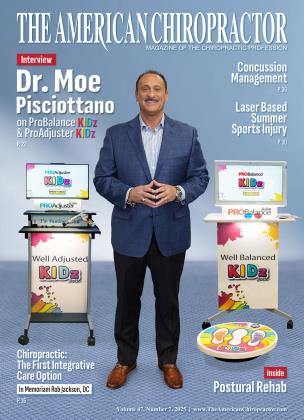A Comprehensive Approach to Postural Rehabilitation
July 1 2025A Comprehensive Approach to Postural Rehabilitation
July 1 2025
IN OUR TECH-SATURATED, SEDENTARY WORLD, postural dysfunction has become an epidemic, triggering a cascade of musculoskeletal issues and diminishing our patients’ quality of life.
As chiropractors, we are uniquely positioned to address this challenge, guiding patients toward optimal postural health and enhancing our practice’s value proposition. This article delves into a comprehensive approach to postural rehabilitation, integrating effective treatment protocols, transparent financial management, and objective progress tracking.
The escalating prevalence of poor posture, often stemming from prolonged sitting, repetitive strain, and device overuse, has significantly increased chronic pain, particularly in the cervical, thoracic, and lumbar regions. It extends beyond mere discomfort, leading to restricted range of motion, muscle imbalances, persistent headaches, neurological deficits, and decreased vitality. Addressing these complex issues demands a holistic approach that transcends symptom relief, focusing on long-term structural correction.
• Comprehensive Assessment: Begin with a thorough postural analysis, incorporating visual observation, digital posture analysis tools (where available), and detailed orthopedic and neurological evaluations. Objectively quantify postural deviations, range of motion limitations, and orthopedic findings. Consolidate these results into a patient-friendly report, such as The Wellness Score, providing a baseline for tracking progress and demonstrating treatment efficacy.
• Individualized Treatment Plans: Develop targeted treatment plans that strategically combine spinal adjustments, soft tissue therapy, and corrective exercises. These plans should focus on restoring proper alignment, strengthening weakened muscles, and improving flexibility. Educate patients on ergonomic principles and lifestyle modifications to support sustained postural health.
• Transparent Care Plans: Foster trust and empower patient decision-making by implementing clear care plans outlining recommended treatment frequency, duration, and associated costs. Divide these plans into phases (acute, rehabilitation, wellness) with defined treatment types and objectives.
• Streamlined Financial Management: Flexible options simplify payment processing, reducing administrative burdens. Features like monthly autopay are particularly advantageous for long-term rehabilitation. They allow for focused attention on patient care and ensure consistent revenue flow.
• Objective Progress Tracking: Regularly reassess patients to monitor changes in posture, range of motion, and orthopedic findings. Document and share these results, including before-and-after posture photos and numerical improvements in evaluation findings, to demonstrate progress and reinforce the value of ongoing care.
Don’t just file the results; share them. Create patient-friendly reports that clearly illustrate their progress. Highlight numerical improvements in range of motion, reduced pain scores, and positive changes in orthopedic findings. Frame these improvements in terms of how they translate to improved daily function and quality of life. For example, “Your cervical range of motion has increased by 20 degrees, meaning you can now turn your head more comfortably while driving.”
Crucially, emphasize positive changes, especially when patients report feeling better. When a patient says, “I feel so much better!” don’t just acknowledge it — quantify it. “That’s fantastic! Look, your forward head posture has improved by X degrees, and your pain score has dropped from a seven to a two. This objective data confirms what you’re feeling.” It reinforces that their subjective improvement is linked to your treatment, strengthening their commitment to ongoing care.
“Don’t just file the results; share them. Create patient friendly reports that clearly illustrate their progress.”
By consistently demonstrating progress, you reinforce the value of your care and build trust. Patients are more likely to adhere to long-term treatment plans when they can see and understand the tangible benefits. This objective feedback solidifies their perception of chiropractic as an integral part of their overall health and wellness, leading to increased patient retention and referrals.
This integrated approach yields significant benefits. Patients experience improved postural aligmnent and function, leading to reduced pain, increased mobility, and enhanced quality of life. The transparency of care plans and objective progress tracking (via The Wellness Score) significantly improve patient compliance. Utilizing efficient systems enhances practice efficiency, freeing up valuable time for patient care. Demonstrating consistent progress and providing exceptional care fosters long-term patient relationships and increases referrals.
Effective patient communication is paramount. It is crucial to shift the patient’s perception from adjustments and therapies as the “product” to understanding that restoring proper posture and function is the true aim. Modalities such as adjustments, traction, and therapeutic exercises are tools to achieve this overarching goal.
When discussing treatment plans, emphasize the timeline and frequency of visits as it relates to achieving specific postural and functional objectives. Instead of merely stating, “You need adjustments three times a week,” explain how those adjustments will contribute to restoring the cervical curve or correcting pelvic alignment. Connecting the dots between treatment frequency and tangible, functional outcomes builds patient understanding and adherence, leading to better long-term results.
Ultimately, communicating the goal of care as restoring posture and function fosters a deeper understanding of chipractic’s value. It transforms patients from passive treatment recipients to active partners in their wellness, reinforcing the importance of consistent care in achieving sustainable improvements. This approach enhances patient satisfaction and compliance and elevates the perception of chiropractic as a vital component of comprehensive health management
By seamlessly integrating comprehensive assessment, targeted treatment, transparent care plans, streamlined financial management, and objective progress tracking, chiropractors can effectively address the growing challenge of poor posture. This holistic approach significantly improves patient outcomes, enhances practice efficiency, and fosters enduring patient relationships. Embracing postural rehabilitation is a strategic investment in our patients’ health and our practices’ long-term vitality.

Dr. Miles Bodzin ran a successful, high-retention wellness practice in his community for nearly two decades. He retired from practice in 2011 to dedicate himself fully to helping chiropractors grow their practices as the founder and CEO of Cash Practice Systems. Dr. Bodzin’s honors include being recognized as a bestselling author and having Cash Practice Systems listed on the Inc. 5000 and the San Diego Business Journal’s “150 Fastest Growing Companies.” With his down-to-earth approach and humble attitude, he connects with and inspires audiences, empowering them to achieve greater success. He can be reached at [email protected].
 View Full Issue
View Full Issue






